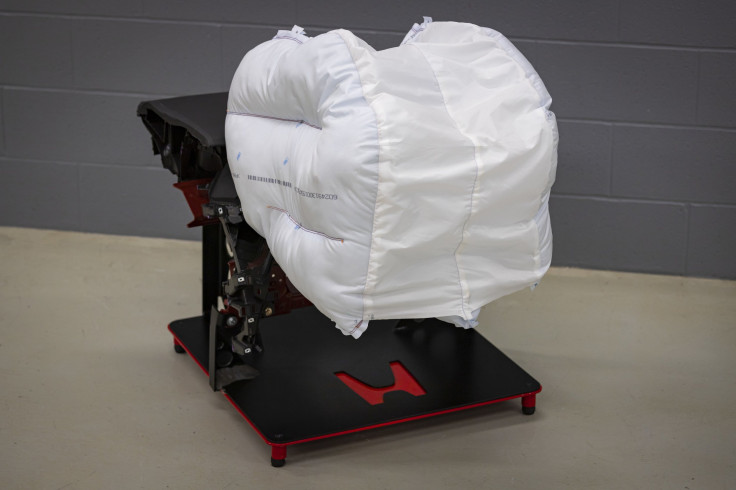
Honda announced the development of an innovative new passenger front airbag technology designed to better protect occupants in a wide range of frontal collision scenarios, including angled crashes between vehicles or a vehicle and another object. Honda plans to apply its advanced airbag design to new products in the United States in 2020.
Engineers led development and testing of the new airbag at Honda R&D Americas, Inc. in Ohio in partnership with Autoliv, one of the company's safety systems suppliers. They base the new design on Honda's commitment to developing technologies that better protect vehicle occupants in a wide range of crash scenarios. In 2017, upwards of 37,000 people lost their lives on U.S. roadways because of motor vehicle traffic crashes, a slight decrease from the previous two years, according to data from the National Highway Traffic Safety Administration (NHTSA).
"This new airbag technology represents Honda's continuing effort to advance safety performance in a wider variety of crash scenarios and reflects the innovative thinking
that our engineers are bringing to the challenge of reducing traffic injuries and fatalities," said Jim Keller, President of Honda R&D Americas, Inc. "Guided by Honda's 'Safety for Everyone' commitment, our engineers recognize that their work on this breakthrough safety technology will have far-reaching effects on peoples' lives for many years to come."
Honda's next-generation airbag reduces the potential for injuries that can occur in a wider variety of frontal impacts. It is beneficial in angled frontal impacts in which lateral collision forces can cause an occupant's head to rotate severely or slide off the airbag, increasing the chance of serious injury.
Unlike conventional airbag systems that rely on a single inflatable compartment, the new system uses four major components: three inflated compartments — a center chamber and two outward-projecting side chambers that create a wide base across the dash — along with a "sail panel" that stretches between the two side chambers at their outermost edge. Operating something like a baseball catcher's mitt, the sail panel catches and decelerates the occupant's head while also engaging the side chambers, pulling them inward to cradle and protect the head, mitigating the potential for injury.
This next-generation airbag technology results from Honda engineers' study of real-world crash events along with research and testing conducted at the company's advanced safety research center in Raymond, Ohio. Honda's Ohio safety center is one the most sophisticated facilities for safety research, development and testing in the world and includes facilities dedicated to advanced crash simulations, pedestrian safety, collision testing and advanced restraint system development and tuning.
Honda also is working to develop and deploy advanced passive safety and active safety systems that can reduce the severity of a collision or help avoid it entirely. Besides passive safety systems such as airbags, seatbelts and advanced crash safety structures like the company's Advanced Compatibility Engineering™ (ACE™) body structure, Honda is aggressively deploying its Honda Sensing® and
AcuraWatch™ suites of safety and driver-assistive systems. Today,
more than 2.5 million vehicles on U.S. roadways are using these technologies, which are now standard or available on all 2019 and newer Honda models and standard on all 2019 and newer Acura sedans and SUVs. The company has committed to making this broad suite of technologies standard on nearly all of its vehicles by 2022.
Combined, Acura and Honda have ten 2019 model-year vehicles—Acura: MDX, RDX1 and RLX; Honda: Accord,1 HR-V,2Insight, CR-V,2 Odyssey,2 Pilot and Ridgeline2 — that earned a TOP SAFETY PICK or TOP SAFETY PICK+ rating from the Insurance Institute for Highway Safety (IIHS). Further, all 2019 model-year Acura and Honda vehicles that have
been fully tested by the National Highway Traffic Safety Administration (NHSTA) have earned a top 5-star Overall Vehicle Score, 15 model nameplates in total.
As a manufacturer of a wide variety of products including automobiles and power sports vehicles, Honda's "Safety for Everyone" commitment
is not limited only to the needs of car drivers and motorcycle riders, but extends
to passengers, pedestrians, and occupants of all vehicles — to everyone sharing the road. Based on this "Safety for Everyone" concept, Honda
is committed to developing innovative safety technologies and equipping them to its automobiles, motorcycles and other power sports products toward Honda's vision for a collision-free mobile society where its customers, and everyone sharing the road, can safely and confidently enjoy the freedom of mobility.
© 2025 Latin Times. All rights reserved. Do not reproduce without permission.






